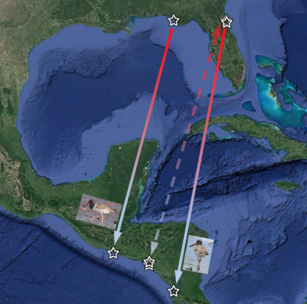
Banded as adults in 2015, Red (47), Red (48), and Red (91) have been reported wintering in Honduras and Nicaragua in the Golfo De Fonseca each year since 2016. These banded American oystercatchers were documented by international partners who contributed photographs and re-sight data to the working group and database. There is little known about the international migration trends of Florida breeding adults or the dispersal of hatch-year oystercatchers. These critical data points just begin to scratch the surface of our knowledge of this group of long-distance migrants.
In 2020, Florida Fish and Wildlife Conservation Commission researchers banded 87 oystercatchers statewide, including 23 adults and 64 chicks. Out of the 64 chicks banded, Red (W51) was banded on 6/27/2020 at Tyndall Air Force Base and Red (W40) on 6/15/2020 at Anastasia State Park. Roughly 4 months after banding, W51 was reported in Barra de Santiago, El Salvador and W40 was reported in Bahía Junquillal, Costa Rica.
While the exact migration paths are unknown, it is nonetheless impressive that 2 oystercatchers migrated over 1000 miles during the peak of a very active gulf hurricane season only 4 months after hatching. It is also noteworthy that these two Pacific Central American sites where the birds were observed are completely new re-sighting locations to the American Oystercatcher Working Group. International reports like these are proof that birds not only have a complex life history, but they also connect the world. American oystercatcher biologists not only received new bird movement information, but also made new connections in the shorebird conservation community.
The biologist who re-sighted the birds wrote a detailed account for the Atlantic Flyway Shorebird Initiative. Read the story in English and Spanish.
(migration photo: The dashed line illustrates the linear distance between annual breeding and wintering locations of Red 47, 48, and 91. The solid lines illustrate the distance between natal and wintering locations of newly banded Red W40 and W51. It should be noted that the actual migration path of each bird is quite different than what is depicted in this illustration.)
|